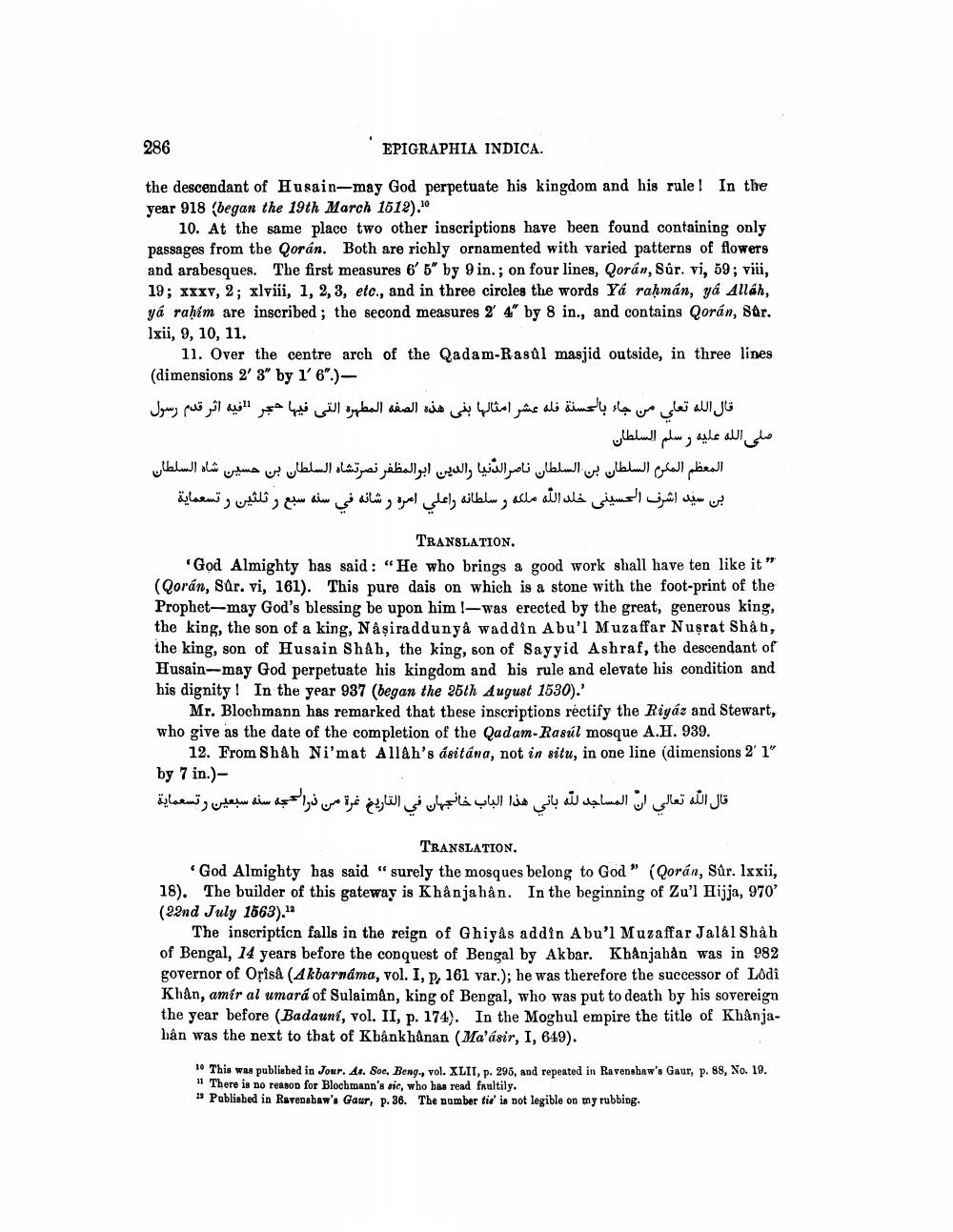________________
286
the descendant of Husain-may God perpetuate his kingdom and his rule! In the year 918 (began the 19th March 1512).10
10. At the same place two other inscriptions have been found containing only passages from the Qorán. Both are richly ornamented with varied patterns of flowers and arabesques. The first measures 6' 5" by 9 in.; on four lines, Qorán, Sûr. vi, 59; viii, 19; xxxv, 2; xlviii, 1, 2, 3, etc., and in three circles the words Yá raḥmán, ya Allah, yá rahim are inscribed; the second measures 2′ 4′′ by 8 in., and contains Qorán, Sur. lxii, 9, 10, 11.
EPIGRAPHIA INDICA.
11. Over the centre arch of the Qadam-Rasûl masjid outside, in three lines (dimensions 2' 3" by 1' 6".)
قال الله تعلى من جاء بالحسنة فله عشر أمثالها بني هذه الصفة المطهرة التي فيها حجر فيه اثر قدم رسول صلى الله عليه وسلم السلطان
المعظم المكرم السلطان بن السلطان ناصرالدنيا والدين ابوالمظفر نصرتشاه السلطان بن حسین شاه السلطان بن سید اشرف الحسيني خلد الله ملکه و سلطانه واعلي امره و شانه في سنة سبع وثلثين وتسعماية
TRANSLATION.
'God Almighty has said: "He who brings a good work shall have ten like it " (Qorán, Sûr. vi, 161). This pure dais on which is a stone with the foot-print of the Prophet-may God's blessing be upon him!-was erected by the great, generous king, the king, the son of a king, Nâşiraddunyâ waddin Abu'l Muzaffar Nusrat Shân, the king, son of Husain Shah, the king, son of Sayyid Ashraf, the descendant of Husain-may God perpetuate his kingdom and his rule and elevate his condition and his dignity! In the year 937 (began the 25th August 1530).'
Mr. Blochmann has remarked that these inscriptions rectify the Rigáz and Stewart, who give as the date of the completion of the Qadam-Rasul mosque A.H. 939.
12. From Shah Ni'mat Allâh's ásitána, not in situ, in one line (dimensions 2' 1" by 7 in.)
قال الله تعالي أن المساجد الله باني هذا الباب خانجہان في التاريخ غرة من فيرا له جه سته سبعين وتسعماية
TRANSLATION.
God Almighty has said "surely the mosques belong to God" (Qorán, Sûr. lxxii, 18). The builder of this gateway is Khánjahan. In the beginning of Zu'l Hijja, 970' (22nd July 1863),
The inscription falls in the reign of Ghiyâs addin Abu'l Muzaffar Jalal Shah of Bengal, 14 years before the conquest of Bengal by Akbar. Khânjahan was in 982 governor of Orisa (Akbarnáma, vol. I, p. 161 var.); he was therefore the successor of Lôdî Khân, amír al umará of Sulaiman, king of Bengal, who was put to death by his sovereign the year before (Badaunt, vol. II, p. 174). In the Moghul empire the title of Khânjahân was the next to that of Khânkhanan (Ma'ásir, I, 649).
10 This was published in Jour. As. Soc. Beng., vol. XLII, p. 295, and repeated in Ravenshaw's Gaur, p. 88, No. 19. There is no reason for Blochmann's sic, who has read faultily.
Published in Ravenshaw's Gaur, p. 36. The number tis' is not legible on my rubbing.




